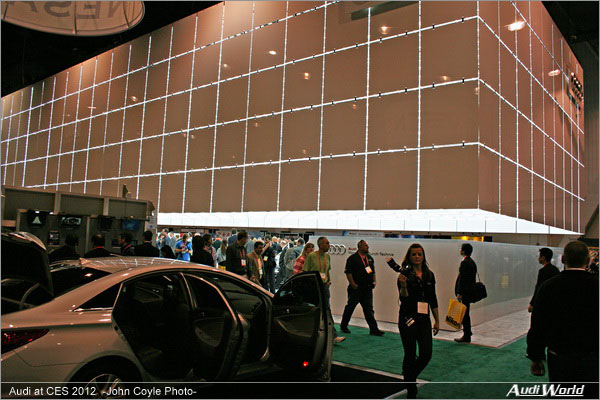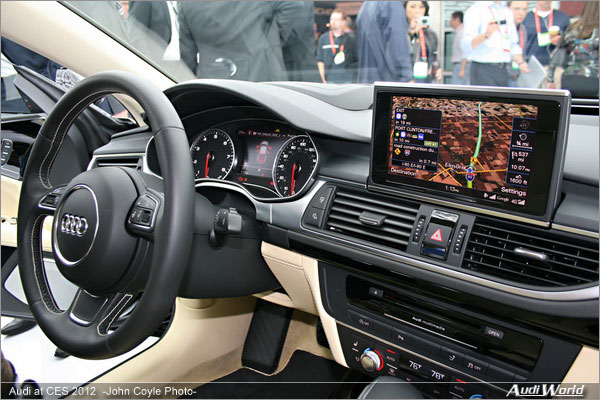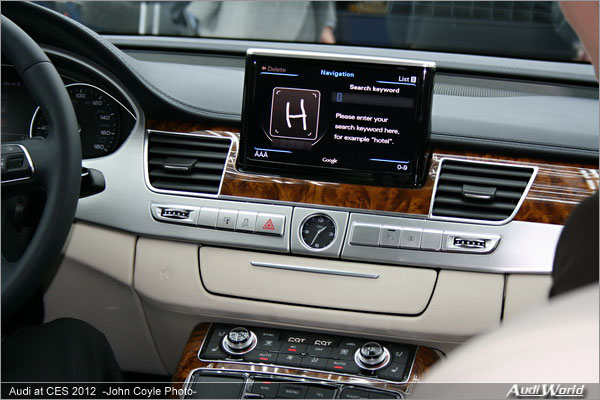January 11, 2012
By: John Coyle
I’ve been covering SEMA since 2006, and I didn’t know what to expect from CES. Let’s just put it this way-the scale of CES makes SEMA look like a Friday night cruise at the local drive in, and the crowd sizes at CES are even more intense.
In the middle of this melee is Audi. The glowing white cube suspended above its floor looks like it’s just descended to Earth, and even amid acres of other “futuristic” displays, it’s striking. Under the cube, it’s bright-like reach-for-your-sunglasses bright—and the sheetmetal of the cars reflects the circuit-like pattern of the cube’s skeleton. Given the whiz-bang technology under the skin, it’s perfectly appropriate.

The Urban concept car which debuted in Frankfurt last year sits at the center of the Audi booth. It was designed to showcase lightweight technologies, and looks like the most incredible soapbox racer ever. It’s powered by a pair of electric motors, and the wheels are hypnotically cool, turbine-like creations with sleek carbon fiber vanes. You could easily envision it parked at spaceport on a futuristic world.
Impressive as it is to see the concept car, the real news here is Audi Connect. Every car equipped with the system will have its own connection to the internet—there’s a slot for a SIM card under the in-dash CD player— and Audi Connect also allows the car to serve as a Wi-Fi hotspot, so passengers will be able to use their devices to stay connected while in transit. Most importantly, the system will provide drivers with navigation, real-time traffic, gas prices and weather. In what feels like a real game changer, the navigation integrates Google Earth, and gives the system a hyper-real quality which makes the blocky representations drivers are used to seeing on nav screens seem eight-bit video games in comparison.

There’s even a Google Street View function, which provides a visual reference of your destination, so you know what you’re looking for before you set out. Sitting in the back of a sleek A8L W12 on the show floor, the woman demonstrating the system for me pulled up an address near the convention center. What came up were a couple of piles of sand and some scattered construction equipment. “It might not be pretty, but it’s real,” she smiled.
But while the technology itself was impressive, the interface was even more so. Drivers can use voice commands to enter addresses—number, street, city zip—all at once, like you’d read to a friend, and you can even use voice prompts to perform Google searches for points of interest. Another thing I thought was particularly cool was the key pad next to the shifter. As you navigate through the screens on the display, the numbers on it disappear, and allow you to simply draw a letter— “H” for hotel, for example—to refine your searches. It might sound a little silly, but seeing a hand-drawn letter appear on the display gave the system a very human feel. And for all of its functionality, it doesn’t intrude on the elegant, intuitive interiors the company is known for.

Audi’s next generation systems will go even farther in refining the interface. In another part of the booth, there was a concept heads up display system which featured three projections: one for the driver, a shared screen in the middle visible to both driver and passenger, and one visible only to the passenger. The wild part was that information could be “passed” between the screens using hand gestures. For example, the passenger could look up a hotel on the center screen, and the driver could then “grab” the address and pull directions on to his screen which would overlay them onto the road. Meanwhile, passenger could watch a video about the hotel on their screen. Said one of the engineers on hand, it’s “some real ‘Minority Report’ type stuff.” And while this particular system isn’t planned for production, future Audi interfaces will let drivers use hand gestures to control the myriad functionality of their onboard systems—”Minority Report” style.
The elephant in the room, of course, is safety. Given that the NTSB recently recommended a complete ban on drivers using cell phones, putting all this technology at the hands of people behind the wheel is still a sticky subject—even at tech-worshipping CES.
During Audi’s afternoon press conference, Audi of America President Johan de Nysschen addressed questions about the safety factor by saying that at the core of Audi’s improvements is a desire to minimize driver distraction, and make the phone and other systems fully integrated with the car, saying “People today don’t view autos like some kind of cocoon where we enter and don’t interact with the outside world.” He then proposed a situation where a man is driving home and gets a call from his wife, who berates him for forgetting their anniversary. After hanging up, the man uses voice commands to have the car direct him to a florist—far safer than juggling a smart phone while trying to drive.
Pointedly, he didn’t explain how the hypothetical driver thinks a gift as trite as flowers would make up for this oversight. But the point was clear – drivers aren’t going to stop using the phone while driving, or as de Nysschen explained “you can’t force water to run uphill.” And he’s right. Drunk driving laws don’t stop people from driving drunk, and cell phone bans wouldn’t work either. He stressed that for Audi, the point is to use technology to minimize distractions, so people can stay connected without endangering themselves or others on the road. Given how impractical an outright ban would be—and how it would stifle development—it seems like the best road forward.
|